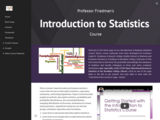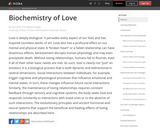921 Results

- Subject:
- Political Science
- Material Type:
- Module
- Date Added:
- 08/21/2018

This course is an exploration of visual art forms and their cultural connections for the student with little experience in the visual arts. It includes a brief study of art history, and in-depth studies of the elements, media, and methods used in creative thought and processes. It is the only resource I have found that approximates techniques, media, and an overview of different processes that is usually the first half of a printed text on art appreciation or an introduction to art. This is geared toward an undergraduate, lower-level student population. The art history survey is inadequate, but combined with another source, like Boundless' art history, this can be a complete text for an Art 100 course.
- Subject:
- Arts and Humanities
- Material Type:
- Assessment
- Lecture
- Module
- Reading
- Syllabus
- Textbook
- Unit of Study
- Provider:
- The Saylor Foundation
- Author:
- Afshan Bokhari
- Amy Gansell
- Andrew E. Hershberger
- Andrew Marvick
- Anne Bertrand-Dewsnap
- Denise Rogers
- Hilda Werschkul
- Jelena Bogdanovic
- Jennifer Palinkas
- Jill Kiefer
- Lynn E. Roller
- Marjorie Munsterberg
- Michelle Greet
- Shaoqian Zhang
- Tracy Musacchio
- William V. Ganis
- Date Added:
- 03/06/2019

This open education resource (OER) contains course materials for a full semester course in Statistics. These course materials were developed by Professors Linda Weiser Friedman (Baruch College, CUNY) and Hershey H. Friedman (Brooklyn College, CUNY).
- Subject:
- Business and Communication
- Economics
- Mathematics
- Social Science
- Statistics and Probability
- Material Type:
- Full Course
- Homework/Assignment
- Lecture
- Lecture Notes
- Module
- Syllabus
- Tutorial
- Provider:
- CUNY
- Provider Set:
- Brooklyn College
- Author:
- Amy Wolfe
- Hershey Friedman
- Linda Weiser Friedman
- Date Added:
- 06/18/2020

Love is deeply biological. It pervades every aspect of our lives and has inspired countless works of art. Love also has a profound effect on our mental and physical state. A “broken heart” or a failed relationship can have disastrous effects; bereavement disrupts human physiology and may even precipitate death. Without loving relationships, humans fail to flourish, even if all of their other basic needs are met. As such, love is clearly not “just” an emotion; it is a biological process that is both dynamic and bidirectional in several dimensions. Social interactions between individuals, for example, trigger cognitive and physiological processes that influence emotional and mental states. In turn, these changes influence future social interactions. Similarly, the maintenance of loving relationships requires constant feedback through sensory and cognitive systems; the body seeks love and responds constantly to interactions with loved ones or to the absence of such interactions. The evolutionary principles and ancient hormonal and neural systems that support the beneficial and healing effects of loving relationships are described here.
- Subject:
- Psychology
- Social Science
- Material Type:
- Module
- Provider:
- Diener Education Fund
- Provider Set:
- Noba
- Author:
- Steve Porges
- Sue Carter
- Date Added:
- 10/16/2018

By the end of this section, you will be able to do the following:
Describe the process of digestion
Detail the steps involved in digestion and absorption
Define elimination
Explain the role of both the small and large intestines in absorption
- Subject:
- Applied Science
- Material Type:
- Module
- Date Added:
- 09/20/2018

By the end of this section, you will be able to do the following:
Discuss the role of neural regulation in digestive processes
Explain how hormones regulate digestion
- Subject:
- Applied Science
- Material Type:
- Module
- Date Added:
- 09/20/2018

By the end of this section, you will be able to do the following:
Explain the processes of digestion and absorption
Compare and contrast different types of digestive systems
Explain the specialized functions of the organs involved in processing food in the body
Describe the ways in which organs work together to digest food and absorb nutrients
- Subject:
- Applied Science
- Material Type:
- Module
- Date Added:
- 09/20/2018

By the end of this section, you will be able to do the following:
Explain why an animal’s diet should be balanced and meet the needs of the body
Define the primary components of food
Describe the essential nutrients required for cellular function that cannot be synthesized by the animal body
Explain how energy is produced through diet and digestion
Describe how excess carbohydrates and energy are stored in the body
- Subject:
- Applied Science
- Material Type:
- Module
- Date Added:
- 09/20/2018

By the end of this section, you will be able to do the following:
Discuss internal and external methods of fertilization
Describe the methods used by animals for development of offspring during gestation
Describe the anatomical adaptions that occurred in animals to facilitate reproduction
- Subject:
- Applied Science
- Material Type:
- Module
- Date Added:
- 09/20/2018

By the end of this section, you will be able to do the following:
Discuss how fertilization occurs
Explain how the embryo forms from the zygote
Discuss the role of cleavage and gastrulation in animal development
- Subject:
- Applied Science
- Material Type:
- Module
- Date Added:
- 09/20/2018

By the end of this chapter, you will be able to do the following:
Describe the roles of male and female reproductive hormones
Discuss the interplay of the ovarian and menstrual cycles
Describe the process of menopause
- Subject:
- Applied Science
- Material Type:
- Module
- Date Added:
- 09/20/2018

By the end of this section, you will be able to do the following:
Explain fetal development during the three trimesters of gestation
Describe labor and delivery
Compare the efficacy and duration of various types of contraception
Discuss causes of infertility and the therapeutic options available
- Subject:
- Applied Science
- Material Type:
- Module
- Date Added:
- 09/20/2018

By the end of this section, you will be able to do the following:
Describe human male and female reproductive anatomies
Discuss the human sexual response
Describe spermatogenesis and oogenesis and discuss their differences and similarities
- Subject:
- Applied Science
- Material Type:
- Module
- Date Added:
- 09/20/2018

By the end of this section, you will be able to do the following:
Describe the process of organogenesis
Identify the anatomical axes formed in vertebrates
- Subject:
- Applied Science
- Material Type:
- Module
- Date Added:
- 09/20/2018

By the end of this section, you will be able to do the following:
Describe advantages and disadvantages of asexual and sexual reproduction
Discuss asexual reproduction methods
Discuss sexual reproduction methods
- Subject:
- Applied Science
- Material Type:
- Module
- Date Added:
- 09/20/2018

By the end of this section, you will be able to do the following:
Explain how vacuoles, present in microorganisms, work to excrete waste
Describe the way in which flame cells and nephridia in worms perform excretory functions and maintain osmotic balance
Explain how insects use Malpighian tubules to excrete wastes and maintain osmotic balance
- Subject:
- Applied Science
- Material Type:
- Module
- Date Added:
- 09/20/2018

By the end of this section, you will be able to do the following:
Explain how hormonal cues help the kidneys synchronize the osmotic needs of the body
Describe how hormones like epinephrine, norepinephrine, renin-angiotensin, aldosterone, anti-diuretic hormone, and atrial natriuretic peptide help regulate waste elimination, maintain correct osmolarity, and perform other osmoregulatory functions
- Subject:
- Applied Science
- Material Type:
- Module
- Date Added:
- 09/20/2018


